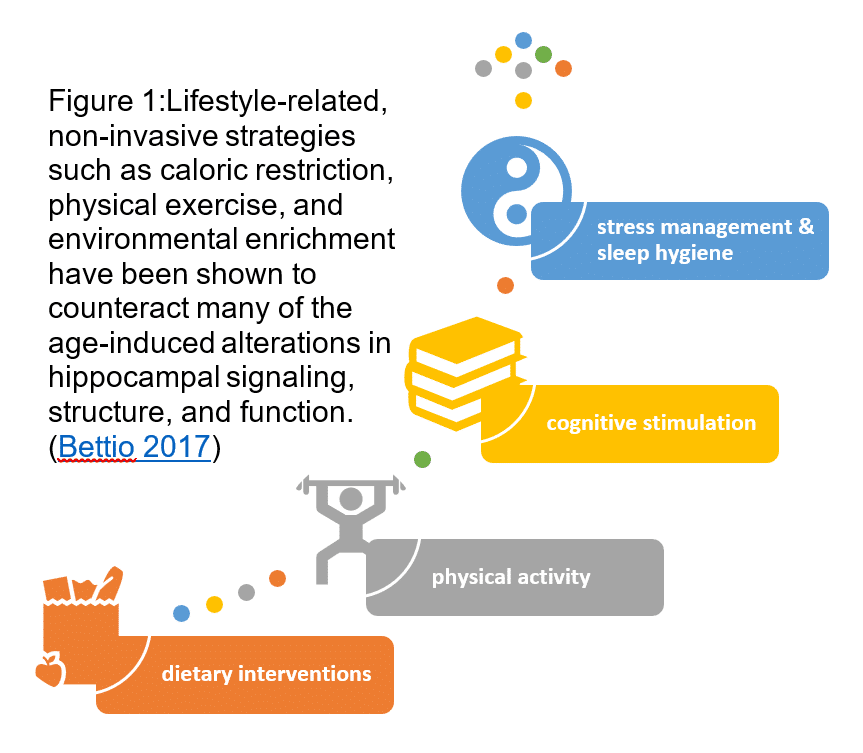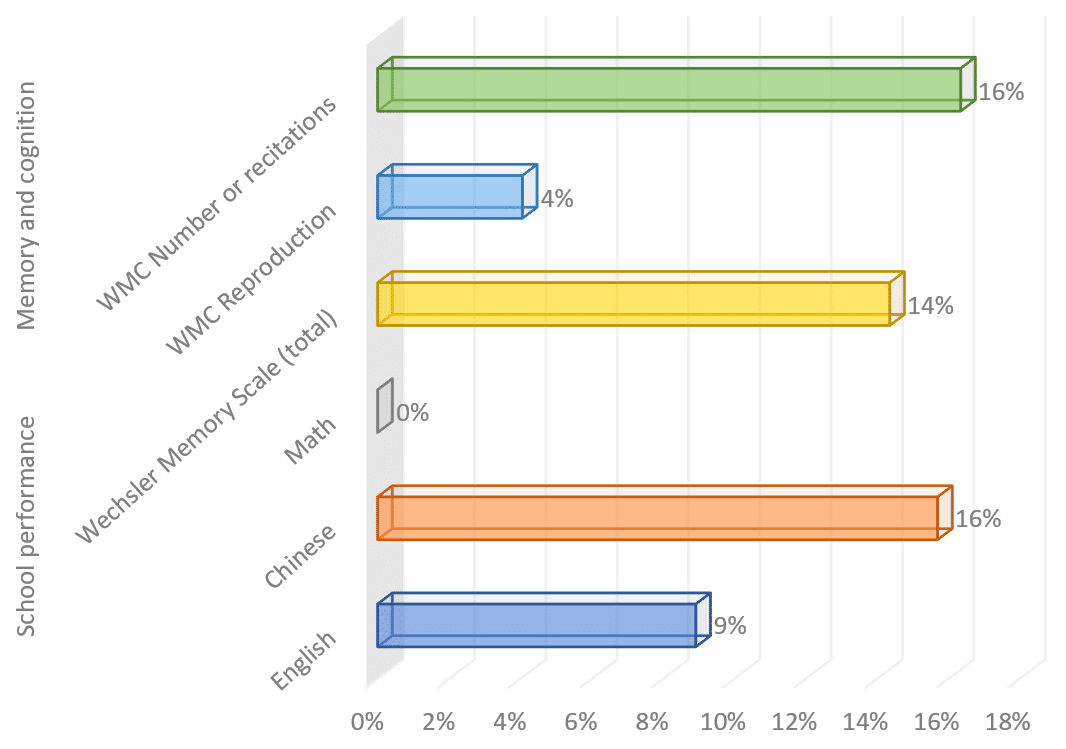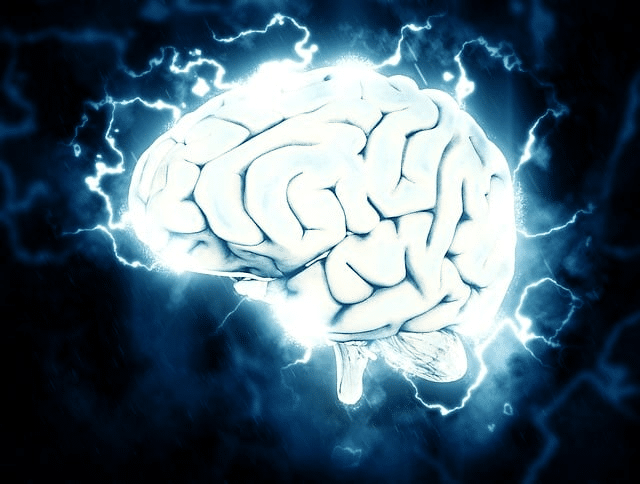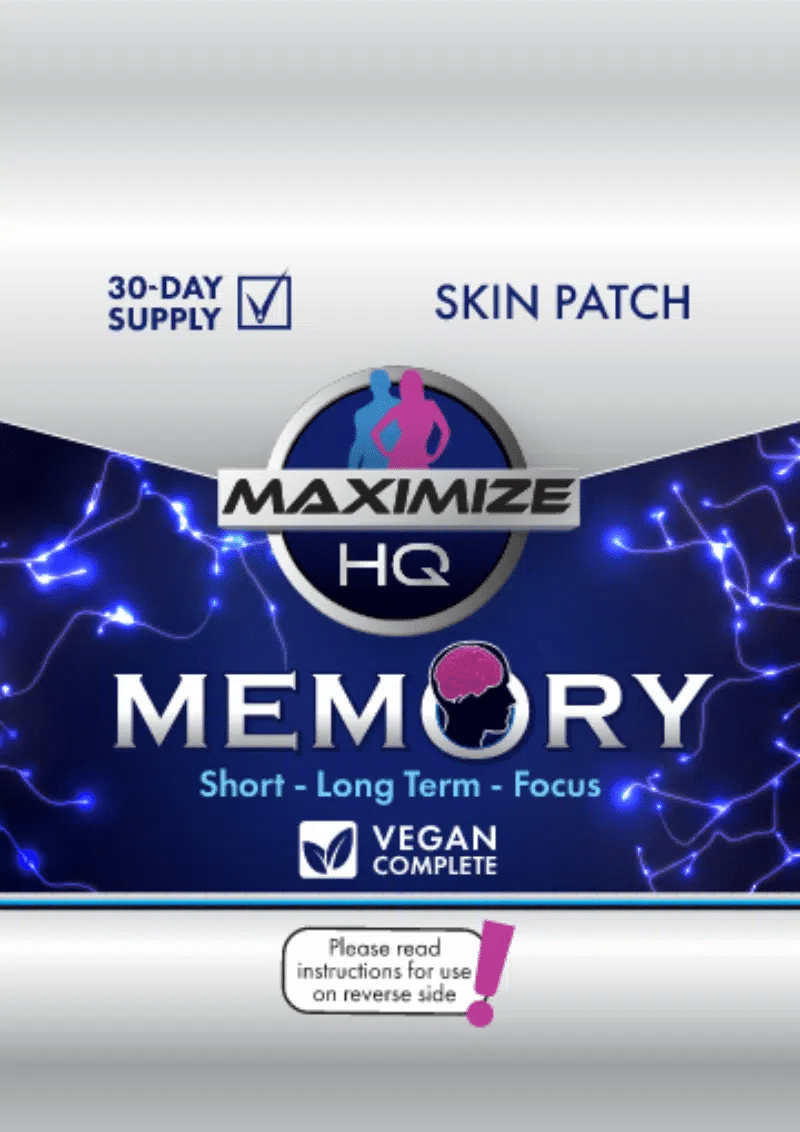Memory and cognition are vital to our everyday lives, allowing us to process information, make decisions, and engage with the world. However, as a consequence of chronic stressors and the inevitable aging process, (Scott 2015, Bettio 2017, Viradia 2022) these cognitive abilities may decline, impacting our overall mental health and well-being. The good news is that there are ways to support and even enhance our memory and cognition.

As shown in Figure 1, there are four basic lifestyle strategies that have been shown time and time again to significantly ameliorate the effects of hippocampal aging and cognitive decline. (Bettio 2017)
However, younger individuals seeking a cognitive edge tend to turn to natural and synthetic nootropics to optimize their brain function. (d’Angelo 2017)
Their growing popularity and surprising efficacy are reason enough for us to dedicate the entire fourth installment of our blog post series to these “smart” compounds.
Understanding Nootropics
The term “nootropic” was coined in 1972 by a Romanian chemist named Corneliu Giurgea, who defined it as a substance that can enhance learning and memory, protect the brain from damage, and have few or no side effects. (Tarfarosh 2017) Since then, the definition of nootropics has expanded to include any substance that can improve one or more aspects of cognitive or mental function alone, such as attention, creativity, motivation, mood, or alertness. (Poschel 1988, Malík 2020)
As Table 1 shows, there are two ways to classify nootropic substances. First, into natural and synthetic nootropics. Natural nootropics are substances that are derived from plants, animals, or foods, such as herbs, vitamins, minerals, amino acids, antioxidants, or omega-3 fatty acids. Synthetic nootropics are substances that are created in laboratories, such as drugs or peptides.

Table 1: Non-exhaustive overview of selected natural and synthetic nootropics, organized by mechanism of action.
Second, based on their mechanism of action or their effect on specific brain systems or neurotransmitters. For example, some nootropics act as stimulants by increasing the activity of dopamine or norepinephrine, while others act as modulators by regulating the activity of glutamate or acetylcholine. (Kumar 2012, Pranav 2013, Halder 2021, Lorca 2021, Malík 2022)
The Power Of Nootropics For Memory And Cognition
Several nootropics have garnered attention for their potential to enhance memory and cognition. While individual responses to nootropic substances may vary, (Schiffano 2020), picking agents that work via distinct, yet synergistic mechanisms, such as those in our 🔗Maximize Memory Skin Patch, maximizes the chances of not only statistically significant, but practically relevant cognitive improvements.
Noopept: Rasputin’s Secret Super Peptide
Noopept is a synthetic peptide (🔗 learn more about peptides in blog #2) that was developed in Russia in the 1990s as a cognitive enhancer. It is similar to piracetam, but more potent and bioavailable. (Ostrovskaia 2002) In addition, it is characterized by a lower incidence of side effects and a generally faster onset of action. (Neznamov 2009)

Figure 2:Neznamov et al. (2009) observed significant improvements in MMSE scores in patients with organic emotionally labile (asthenic) disorder of vascular origin (top) and post-concussional syndrome (bottom).
*Significant differences from baseline (p < 0.01). The ordinate shows scores in points.
Noopept works by increasing the levels of nerve growth factor (NGF) and brain-derived neurotrophic factor (BDNF), which are proteins that promote neurogenesis and neuroplasticity in brain cells. It also modulates the activity of acetylcholine and glutamate, which are neurotransmitters that play key roles in memory and learning. (Ostrovskaia 2010, Vakhitova 2016, Kolbaev 2021)
Its mechanism of action and results from animal studies lead scientists to believe that Noopept holds great promise for improving various aspects of memory and cognition in healthy adults. Human clinical trials have so far focused primarily on patients with mild cognitive impairment, for whom further research is needed. Neznamov et al. (2009) report significant improvements in several aspects of mood and cognition (Figure 2). With >10% higher scores on the Minimal Mental State Examination (MMSE, cf. Tombaugh 1992) in response to 8 weeks of 2x10mg/d of the nootropic peptide.
Huperzine A: A Natrual Alkaloid
Next on the ingredient list is Huperzine A, a natural alkaloid that is extracted from the Chinese club moss plant (Huperzia serrata). It works by inhibiting the enzyme acetylcholinesterase, which breaks down acetylcholine in the brain. (Damar 2016) By increasing the levels of acetylcholine, huperzine A enhances memory and learning, as well as cognitive functions such as attention and alertness.

Figure 3: Improvements in various markers of memory, cognition, and learning in 34 junior middle school students in response to 2×50 µg/d of Huperzine A for four weeks.
Calculated based on scores on the Wechsler Memory Scale and learning performance data from Sun 1999.
Huperzine A has been shown to improve memory and cognition in healthy adults and adolescents, (Sun 1999) as well as in patients with Alzheimer’s disease or vascular dementia. (Yang 2013, Shukla 2022)
Huperzine A has also been reported to have neuroprotective, antioxidant, anti-inflammatory, and antidepressant effects, all of which can occur during both pathological (dementia, Parkinson’s, Alzheimer’s) as well as healthy brain aging. (Friedli 2021, Shukla 2022)
Vinpocetine: “Viagra® For The Brain”
Vinpocetine is a synthetic derivative of vincamine, a natural alkaloid that is extracted from the periwinkle plant (Vinca minor). As Jha et al. point out 2012 review, it is essentially “Viagra® for the brain” (Jha 2012). It works by increasing cerebral blood flow, which improves the delivery of oxygen and nutrients to the brain. (Kiss 1996) It also modulates the activity of sodium, potassium, and calcium channels that regulate neuronal excitability and neurotransmission and has also been reported to have neuroprotective, antioxidant, and anti-inflammatory effects. (Bönöczk 2000, Zhang 2018)
Vinpocetine has been shown to improve memory and cognition in patients with mild cognitive impairment or Alzheimer’s disease. For example, a study from Nigeria reports a statistically highly significant 37% reduction in errors on a standardized memory recall test in response to 12 weeks of 2×5 mg vinpocetine per day in 56 cognitively impaired subjects. (Ogunrin 2014) Anecdotal evidence suggests notable benefits in healthy individuals, as well, so it is only slightly surprising that vinpocetine also made the list of commonly (ab)used nootropics in a meta-analysis by Sharif et al. (2021) that reviewed 45 studies to better understand the use and abuse of prescription nootropics, by university students worldwide.
Hordenine: Stimulating Neurotransmitter Maximizer
Hordenine is a natural phenylethylamine found in several plants such as barley, bitter orange, cactus, and algae. It works by increasing levels of norepinephrine and dopamine, neurotransmitters that increase alertness, motivation, mood, and energy. It also inhibits the enzyme monoamine oxidase (MAO), which breaks down these neurotransmitters in the brain.
As a stimulant, hordenine can be seen as an ideal complement to the previously discussed neuromodulatory non-stimulant compounds. Although there is limited scientific evidence for its stand-alone benefits on cognition and memory, by inhibiting the breakdown of key neurotransmitters in the brain, Hordenine may both enhance cognition and prolong the effects of other neurotransmitter modulators in the patch. In addition, several other compounds with similar MAO inhibitory activity have shown potential utility in the treatment of neurodegenerative diseases, including Alzheimer’s disease. (Delumeau 1994; Manzoor 2020, Behl 2021). And, for what it’s worth, hordenine has been reported to have thermogenic, analgesic, and antidepressant effects. (Athilli 2022)
Yohimbine: Stimulating Blood Flow Enhancer
Last on the 🔗Maximize Memory Skin Patch ingredient list is yohimbine, a natural indole alkaloid extracted from the bark of the Yohimbe tree (Pausinystalia yohimbe) or synthesized in laboratories. It works by blocking alpha-2 adrenergic receptors and is best known for its stimulating effects.
The reason yohimbine rounds out the Memory Patch formula perfectly, however, is that it not only mirrors the stimulating effects of hordenine, albeit via a different receptor but also increases blood flow to the brain and other parts of the body. In fact, yohimbine has a long history of use as a natural Viagra®…but unlike vinpocetine, not specifically for the brain. (Ernst 1998, Guay 2002, Jabir 2022) It is also popular in the health and fitness community as an ingredient in purported fat burners, with impressive results from an oft-cited 2002 study by Ostojic in elite male soccer players (Ostojic 2002) – whether the soccer players were not just leaner but also smarter at the end of the study was not determined, by the way.
Conclusion:
Nootropics offer exciting possibilities for improving memory and cognition, helping people of all ages optimize their mental performance. Scientific studies have explored various compounds such as Noopept, Huperzine A, Vinpocetine, Hordenine, and Yohimbine, demonstrating their individual and synergistic benefits. By harnessing the power of these substances in a safe and informed manner, you can unlock the full potential of your brain health for memory and cognitive performance.
Remember, responsible use and awareness of potential side effects are critical. In addition, nootropics should not be considered a solution for severe cognitive impairment or dementia and should be complemented by healthy lifestyle choices, including regular exercise, a balanced diet, quality sleep, and mental stimulation (Figure 1).
Time-Release Memory Patch
References
Athilli, L. and Balasubramaniam, A., 2022. Hordenine: Pharmacological, phytochemical, pharmacokinetic, and analytical review of the literature. Annals of Phytomedicine, 11(1), pp.121-132.
Behl, T., Kaur, D., Sehgal, A., Singh, S., Sharma, N., Zengin, G., Andronie-Cioara, F.L., Toma, M.M., Bungau, S. and Bumbu, A.G., 2021. Role of monoamine oxidase activity in Alzheimer’s disease: an insight into the therapeutic potential of inhibitors. Molecules, 26(12), p.3724.
Bettio, L.E., Rajendran, L. and Gil-Mohapel, J., 2017. The effects of aging in the hippocampus and cognitive decline. Neuroscience & Biobehavioral Reviews, 79, pp.66-86.
Bönöczk, P., Gulyás, B., Adam-Vizi, V., Nemes, A., Kárpáti, E., Kiss, B., Kapás, M., Szántay, C., Koncz, I., Zelles, T. and Vas, A., 2000. Role of sodium channel inhibition in neuroprotection: effect of vinpocetine. Brain research bulletin, 53(3), pp.245-254.
Damar, U., Gersner, R., Johnstone, J.T., Schachter, S. and Rotenberg, A., 2016. Huperzine A as a neuroprotective and antiepileptic drug: a review of preclinical research. Expert review of neurotherapeutics, 16(6), pp.671-680.
d’Angelo, L.S.C., Savulich, G. and Sahakian, B.J., 2017. Lifestyle use of drugs by healthy people for enhancing cognition, creativity, motivation and pleasure. British Journal of Pharmacology, 174(19), pp.3257-3267.
Ernst, E. and Pittler, M.H., 1998. Yohimbine for erectile dysfunction: a systematic review and meta-analysis of randomized clinical trials. The Journal of urology, 159(2), pp.433-436.
Friedli, M.J. and Inestrosa, N.C., 2021. Huperzine A and its neuroprotective molecular signaling in Alzheimer’s disease. Molecules, 26(21), p.6531.
Guay, A.T., Spark, R.F., Jacobson, J., Murray, F.T. and Geisser, M.E., 2002. Yohimbine treatment of organic erectile dysfunction in a dose-escalation trial. International journal of impotence research, 14(1), pp.25-31.
Halder, S., Anand, U., Nandy, S., Oleksak, P., Qusti, S., Alshammari, E.M., Batiha, G.E.S., Koshy, E.P. and Dey, A., 2021. Herbal drugs and natural bioactive products as potential therapeutics: A review on pro-cognitives and brain boosters perspectives. Saudi Pharmaceutical Journal, 29(8), pp.879-907.
Jabir, N.R., Firoz, C.K., Zughaibi, T.A., Alsaadi, M.A., Abuzenadah, A.M., Al-Asmari, A.I., Alsaieedi, A., Ahmed, B.A., Ramu, A.K. and Tabrez, S., 2022. A literature perspective on the pharmacological applications of yohimbine. Annals of Medicine, 54(1), pp.2849-2863.
Jha, M.K., Rahman, M.H. and Sheikh, H., 2012. Vinpocetine: a smart drug and a smart nutrient: a review. International Journal of Pharmaceutical Sciences and Research, 3(2), p.346.
Kiss, B. and Kárpáti, E., 1996. Mechanism of action of vinpocetine. Acta pharmaceutica Hungarica, 66(5), pp.213-224.
Kolbaev, S.N., Sharonova, I.N. and Skrebitsky, V.G., 2021. Cellular and Receptor Mechanisms of Action of Nootropic and Neuroprotective Peptides Used in Clinical Practice. Human Physiology, 47(8), pp.870-877.
Kumar, G.P. and Khanum, F., 2012. Neuroprotective potential of phytochemicals. Pharmacognosy reviews, 6(12), p.81.
Lorca, C., Mulet, M., Arévalo-Caro, C., Sanchez, M.Á., Perez, A., Perrino, M., Bach-Faig, A., Aguilar-Martínez, A., Vilella, E., Gallart-Palau, X. and Serra, A., 2021. Plant-derived nootropics and human cognition: A systematic review. Critical Reviews in Food Science and Nutrition, pp.1-25.
Malík, M. and Tlustoš, P., 2022. Nootropics as cognitive enhancers: types, dosage and side effects of smart drugs. Nutrients, 14(16), p.3367.
Malík, M. and Tlustoš, P., 2023. Nootropic Herbs, Shrubs, and Trees as Potential Cognitive Enhancers. Plants, 12(6), p.1364.
Manzoor, S. and Hoda, N., 2020. A comprehensive review of monoamine oxidase inhibitors as Anti-Alzheimer’s disease agents: A review. European Journal of Medicinal Chemistry, 206, p.112787.
Nakamura, K., 2002. Aniracetam: its novel therapeutic potential in cerebral dysfunctional disorders based on recent pharmacological discoveries. CNS drug reviews, 8(1), pp.70-89.
Neznamov, G.G. and Teleshova, E.S., 2009. Comparative studies of Noopept and piracetam in the treatment of patients with mild cognitive disorders in organic brain diseases of vascular and traumatic origin. Neuroscience and behavioral physiology, 39(3), p.311.
Ogunrin, A.O., 2014. Effect of vinpocetine (cognitol™) on cognitive performances of a nigerian population. Annals of medical and health sciences research, 4(4), pp.654-661.
Ostojic, S.M., 2006. Yohimbine: the effects on body composition and exercise performance in soccer players. Research in Sports Medicine, 14(4), pp.289-299.
Ostrovskaia, R.U., Gudasheva, T.A., Voronina, T.A. and Seredenin, S.B., 2002. The original novel nootropic and neuroprotective agent Noopept. Eksperimental’naia i Klinicheskaia Farmakologiia, 65(5), pp.66-72.
Ostrovskaia, R.U., IuV, V., MKh, S., Iamidanov, R.S., Sadovnikov, S.V., Kapitsa, I.G. and Seredenin, S.B., 2010. On the mechanism of Noopept action: decrease in activity of stress-induced kinases and increase in expression of neutrophines. Eksperimental’naia i Klinicheskaia Farmakologiia, 73(12), pp.2-5.
Poschel, B.P.H., 1988. New pharmacological perspectives on nootropic drugs. In Handbook of Psychopharmacology: Volume 20 Psychopharmacology of the Aging Nervous System (pp. 437-469). Boston, MA: Springer US.
Pranav, Joshi C., 2013. A review on natural memory enhancers (Nootropics). Unique Journal of Engineering and advanced sciences, 1(01), pp.8-18.
Scott, S.B., Graham-Engeland, J.E., Engeland, C.G., Smyth, J.M., Almeida, D.M., Katz, M.J., Lipton, R.B., Mogle, J.A., Munoz, E., Ram, N. and Sliwinski, M.J., 2015. The effects of stress on cognitive aging, physiology and emotion (ESCAPE) project. BMC psychiatry, 15(1), pp.1-14.
Sharif, S., Guirguis, A., Fergus, S. and Schifano, F., 2021. The use and impact of cognitive enhancers among university students: a systematic review. Brain sciences, 11(3), p.355.
Shukla, M., Wongchitrat, P. and Govitrapong, P., 2022. A Synopsis of Multitarget Potential Therapeutic Effects of Huperzine A in Diverse Pathologies–Emphasis on Alzheimer’s Disease Pathogenesis. Neurochemical Research, 47(5), pp.1166-1182.
Sun, Q.Q., Xu, S.S., Pan, J.L., Guo, H.M. and Cao, W.Q., 1999. Huperzine-A capsules enhance working memory, and learning performance in 34 pairs of matched adolescent students. Zhongguo yao li xue bao= Acta pharmacologica Sinica, 20(7), pp.601-603.
Tarfarosh, S.F.A., Tromboo, U. and Bhat, F., 2017. Search for a perfect Nootropic supplement combination –Can we increase human intelligence by nutritional supplements?. Journal of Pharmacognosy and Phytochemistry, 6(5), pp.1020-1024.
Tombaugh, T.N. and McIntyre, N.J., 1992. The mini‐mental state examination: a comprehensive review. Journal of the American Geriatrics Society, 40(9), pp.922-935.
Vakhitova, Y.V., Sadovnikov, S.V., Borisevich, S.S., Ostrovskaya, R.U., Gudasheva, T.A. and Seredenin, S.B., 2016. Molecular mechanism underlying the action of substituted Pro-Gly dipeptide Noopept. Acta Naturae (англоязычная версия), 8(1 (28)), pp.82-89.
Viradia, N., Paredes, J.G. and Hassan, S., 2022. The Effects of Chronic Stress on Neuroanatomy and Cognitive Function. [Preprint]
Yang, G., Wang, Y., Tian, J. and Liu, J.P., 2013. Huperzine A for Alzheimer’s disease: a systematic review and meta-analysis of randomized clinical trials. PloS one, 8(9), p.e74916.
Zhang, Y.S., Li, J.D. and Yan, C., 2018. An update on vinpocetine: New discoveries and clinical implications. European journal of pharmacology, 819, pp.30-34.






